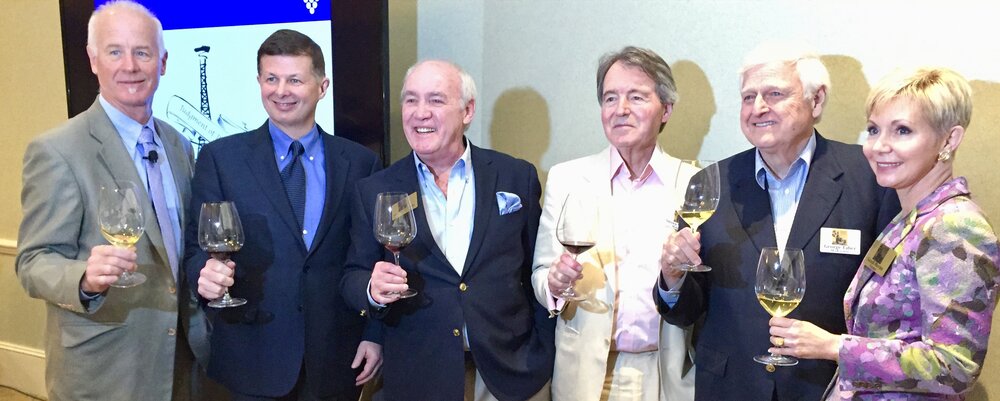
When it comes to charity wine events, few have the caché of the Naples Winter Wine Festival. Widely considered one of the most successful in the U.S., the event is held every January at the tony Ritz-Carlton Golf Resort on Florida's balmy west coast.
Well-heeled, philanthropically minded patrons pay $10,000 per couple to attend a weekend of spectacular food and wine events featuring the industry's brightest stars and most revered legends. This glamorous event is held for a wonderful cause and, since its inception in 2001, has raised over $146 million for the Naples Children and Education Foundation which has benefited over 40 local children's charities.
The 2016 Naples Winter Wine Festival kicked off a weekend of vinous revelry with a very special tasting and luncheon commemorating the 40th anniversary of The Judgment of Paris, a wine tasting held in Paris in 1976 that changed the wine world forever. The tasting pitted a selection of France's most highly regarded wines against a selection of American wines which, at the time, weren't well-known outside of California's west coast.

Steven Spurrier + George Taber chatting before the tasting
In a surprising defeat, the American wines trounced the French, forever establishing the U.S. as a vinous force to be reckoned with.
The Vintage Cellar, a Celebration of The Judgment of Paris featured a retrospective tasting of vintages of the fêted American wines (the Chateau Montelena Chardonnay and Stag's Leap Wine Cellars S.L.V. Estate Cabernet Sauvignon) followed by a luncheon at the Ritz-Carlton Golf Resort's restaurant, Lemonía.
The tasting was moderated by the very men involved in this historic event 40 years ago: Steven Spurrier, event organizer and proprietor of L'Academie du Vin; Bo Barrett, CEO and Master winemaker of Chateau Montelena; Ted Baseler President and CEO of Stag's Leap Wine Cellars; and George Taber, editor for Time Magazine who's coverage of the event brought it to national attention.
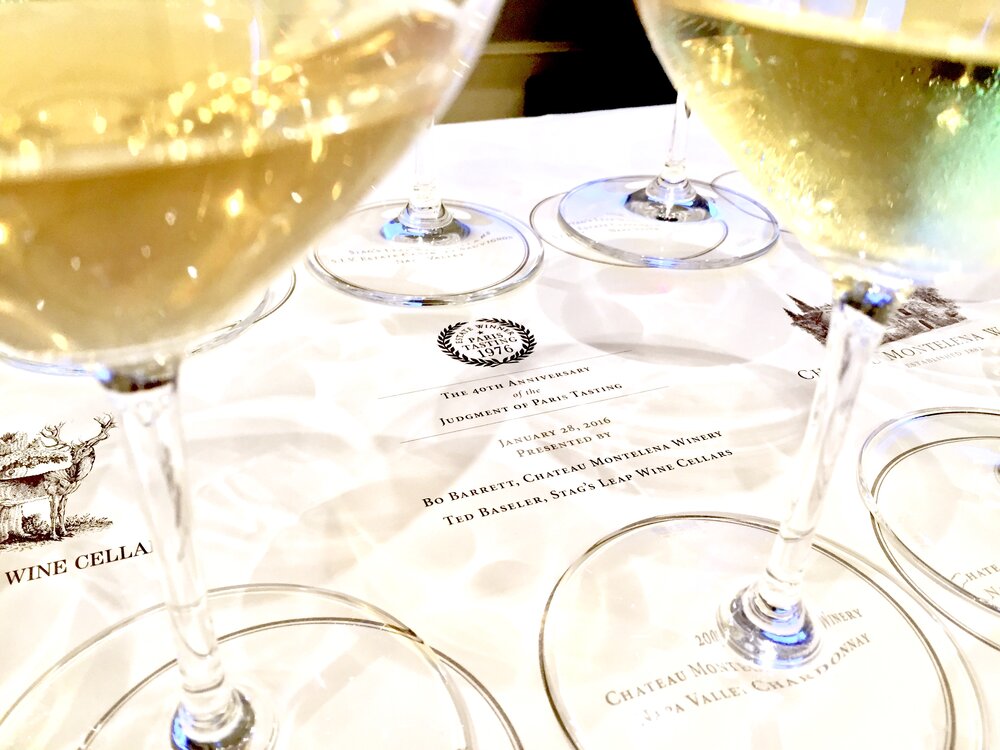
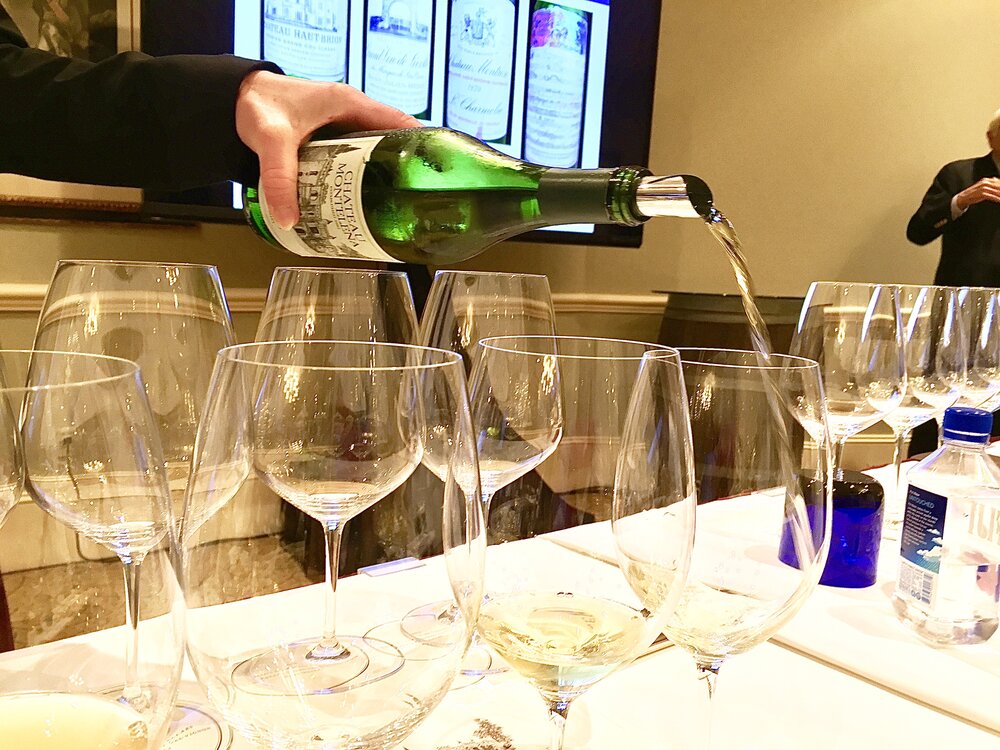
The service of these special wines was executed by a bevy of Master Sommeliers and many notable wine industry names were in attendance including Emily and Paul Michael of Peter Michael Winery, the Festival's 2016 Honored Vintner; Jean-Charles Boisset of the Boisset Collection; and Violet Grgich of Grgich Hills Estate who's father, Mike Grgich, was the winemaker for Chateau Montelena at the time of the tasting and crafted the legendary winning Chardonnay.
The day of the Naples tasting, Englishman Steven Spurrier, nattily dressed in a cream-colored linen suit with pink shirt and matching pocket square, kicked off the talk by recounting his introduction to the world of wine and sharing some very memorable experiences in the vineyards and cellars of Spain, Germany, France and Portugal.
Spurrier and his wife eventually settled in Paris where they purchased a wine shop, "I was the first...to sell the red wines of Guigal, Chateau Beaucastel and Chateau Rayas. I was constantly on the lookout for wines that spoke firmly of where they came from."
He also began hosting a variety of wine tastings featuring new producers which is where the idea for the Paris tasting came from, "The plan was to select wines only from the newish, boutique wineries to show the tasters the cutting edge of California."
Spurrier never suspected how the results would forever impact the wine world. He also voiced his disdain for a certain film made about the tasting (for my review of Bottle Shock, please click here). He was, however, quite excited about another film slated for release in July 2017 entitled The Judgment of Paris which will strive to provide a more accurate account of the details surrounding the event (please watch video above for Spurrier’s complete talk).
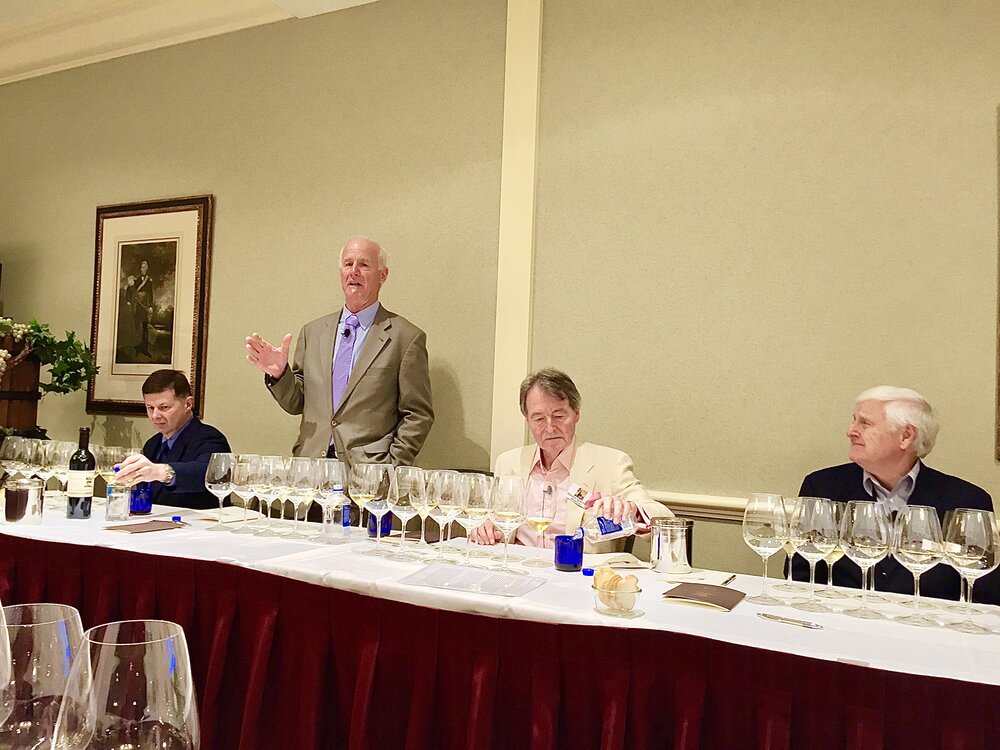
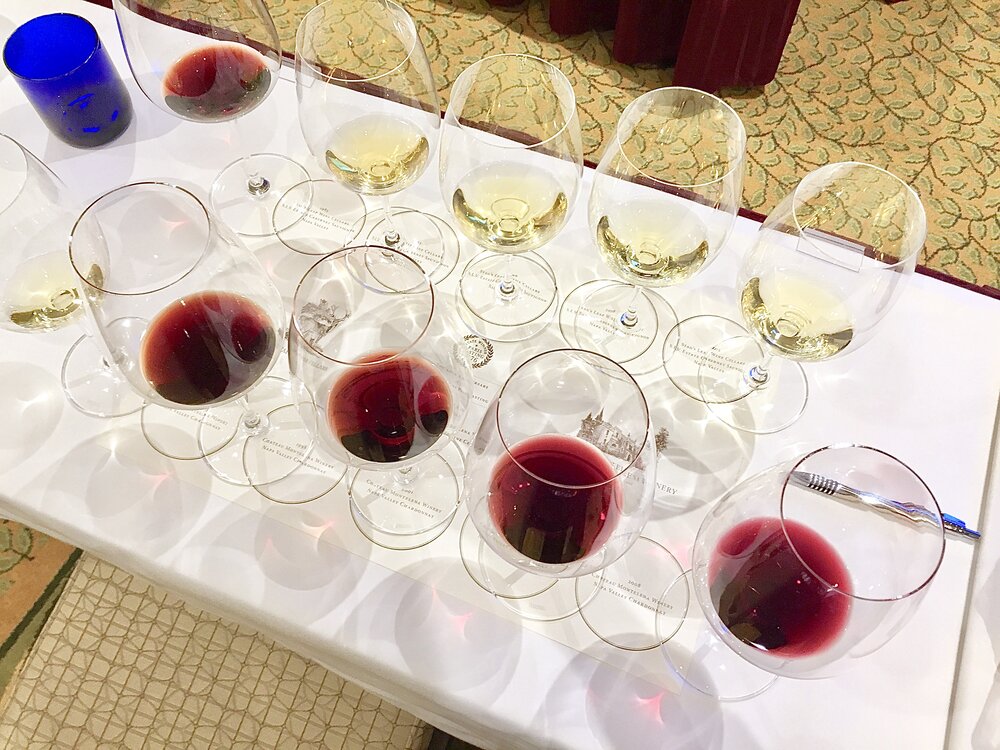
Next, the dapper and distinguished George Taber spoke, impressing upon us how close he'd come to missing the tasting altogether. Even when he arrived, it wasn't until he was given a score card featuring the names and order of the wines during the tasting and listening to the judges' comments (the judges tasted the wines blind) that he realized he had a story, "I heard one of the French judges exclaim while sampling a wine, 'Ah, the majesty of France' but when I looked at the score card I could see he was drinking the Freemark Abbey Cabernet from California!"
Taber went on to exclaim, "[the tasting] was a turning point in California wine...it definitely brought up everybody's game."
The affable Bo Barrett expounded on the importance of the tasting following the ravages of Prohibition on the California wine industry, "[the judgment of Paris] was the nail in the coffin of Prohibition." On his own contribution, "I was just a soldier, twenty years old and there were only three of us working in the cellar making just $3.15 an hour! It was the right wine at the right place on the right day...but we had the dream."
On his legacy, "like a mason, I look back on my work which has stood the test of time and I'm proud of that."
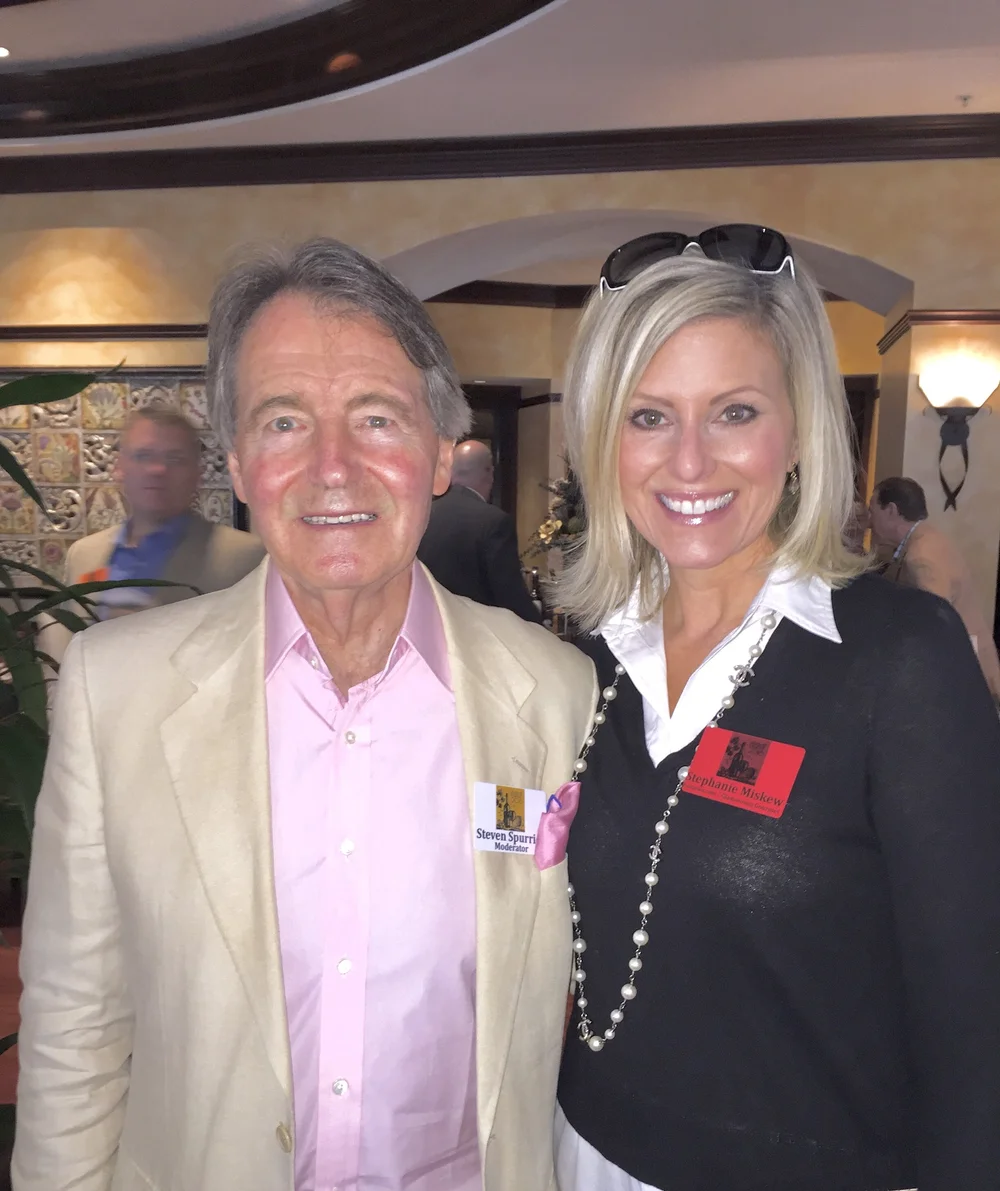
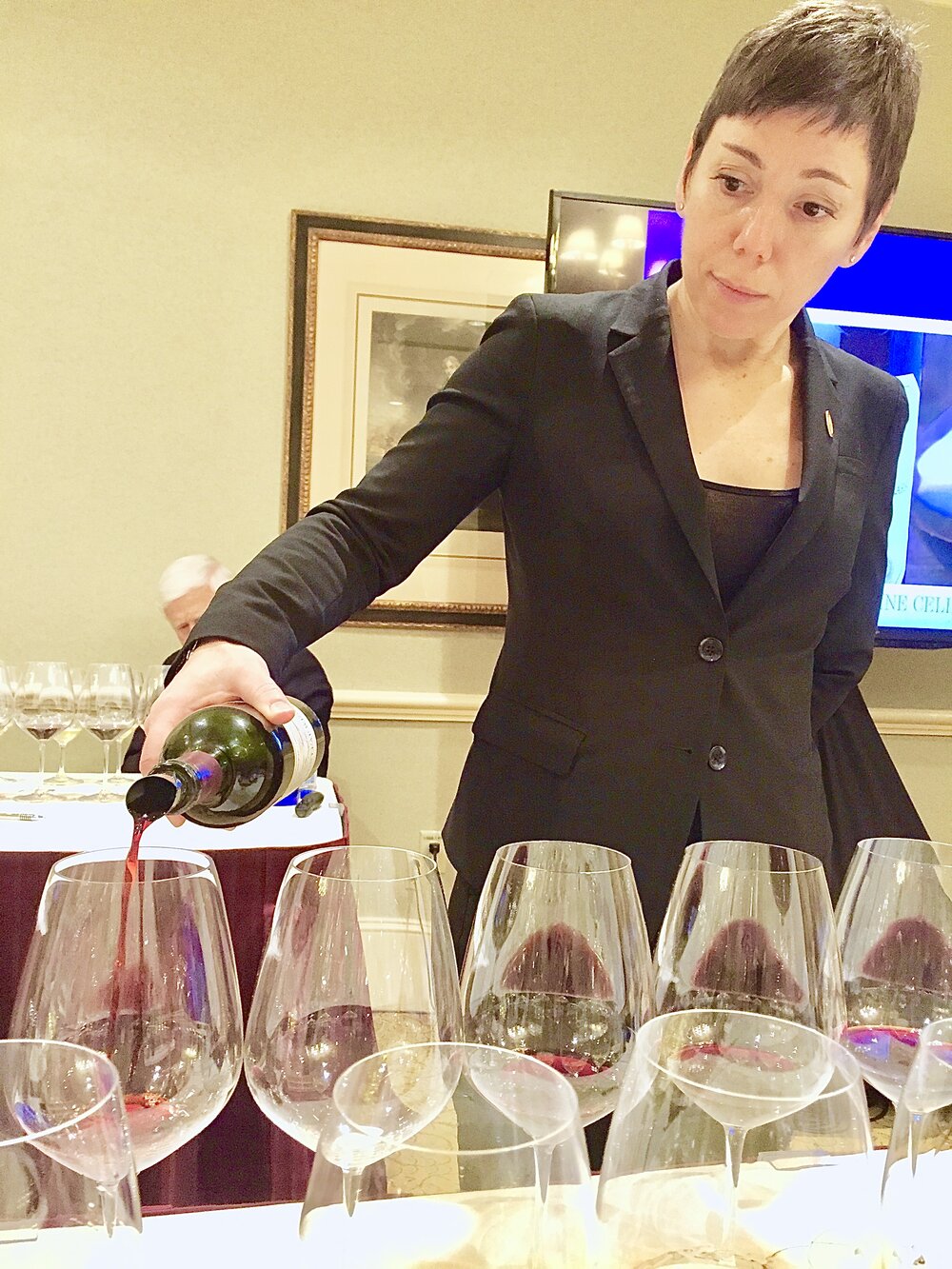
A tasting of the Chateau Montelena Chardonnay from the 1992, 1998, 2001, 2004 and 2008 vintages (all poured from magnums) revealed wines which, across the board, had aged with incredible grace. They were still fresh and lively with ample fruit and layers of delicious flavor. Older vintages expressed concentrated notes of baked apple, butterscotch and spice while the younger wines were rife with lemon verbena, apple tart and spiced pear balanced by a lovely minerality.
While not a part of the actual 1976 event, Ted Baseler, President and CEO of Ste. Michelle Wine Estates current owner of Stag's Leap Wine Cellars, has enjoyed an esteemed thirty year career in the wine industry. The bottle which won the competition was then-owner Warren Winiarski's first vintage and it was only the vineyard's second leaf - very young by vineyard standards!
Baseler proudly informed us a bottle of the winning Cabernet, the 1973 Stag's Leap S.L.V. Cabernet Sauvignon, is on display at the Smithsonian National Museum of American History in Washington, DC as one of the "101 Objects that Made America"(don't worry, the winning Chateau Montelena Chardonnay is there too).

Our special tasting of the Estate S.L.V. Cabernet Sauvignon included the 1983, 1993, 1998, 2008 and 2012 vintages and revealed wines which had definitely stood the test of time. The older vintages still possessed plenty of tannins and acid while dried fruits such as currant and cherry were accompanied by notes of earth, feu de bois, cocoa and spice. Conversely, the younger 2008 and 2012 vintages exhibited gorgeous layers of lush, ripe dark fruit, dark chocolate and coffee which were delightfully balanced and elegant.
A Q&A session at the end of the tasting revealed even more interesting insights from our speakers. When asked what has changed most in winemaking since 1976, Barrett replied, "Fruit handling and access to better cultivars are probably the biggest changes for us since then. The grapes picked for the Chardonnay that won the tasting were picked mid-afternoon and now we realize the importance of picking at night."
When asked about the upcoming film, The Judgment of Paris set to film this Summer, Baseler added, "the new film will tell the story of the of Stag's Leap Wine Cellars, much like Bottle Shock focused on the Barretts and Chateau Montelena. It should be released in mid-2017."
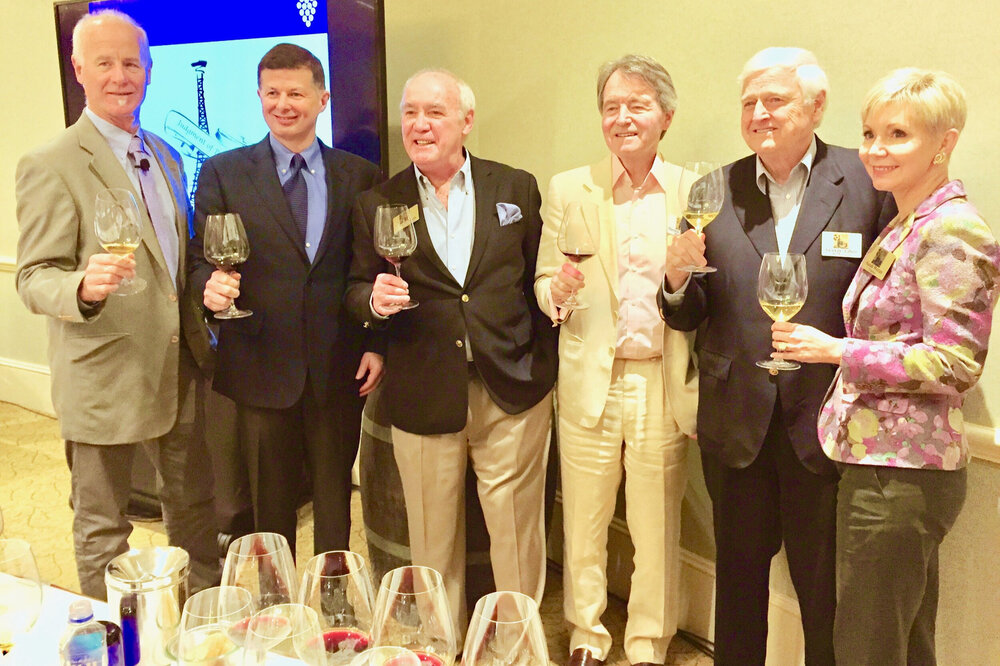
Someone also asked why the French judges at the tasting were blindsided by the results to which Spurrier responded, "At the time of the tasting the judges knew the wines of their particular regions and weren't familiar with US wines. It was almost a social event for them." Spurrier also cheekily added, "You could also sum it up in one sentence, 'How a Croat and a Pole made history thanks to an Englishman!'"
This very special event was the perfect start to yet another successful weekend in Naples for a wonderful cause. In addition to the tasting and luncheon, the festival also featured sixteen vintner dinners held in elegant private homes, the legendary Great Expectations auction and a Celebration Brunch. For more information on the Naples Winter Wine Festival please click here.
When it comes to charity wine events, few have the caché of the Naples Winter Wine Festival. Widely considered one of the most successful in the U.S., the event is held every January at the tony Ritz-Carlton Golf Resort on Florida’s balmy west coast. Well-heeled, philanthropically minded patrons pay $10,000 per couple to attend a weekend of spectacular food and wine... Read More
The post The 40th Anniversary of “The Judgment of Paris” Celebrated at The Naples Winter Wine Festival! appeared first on The Glamorous Gourmet.
Coco Chanel, Bette Davis, Oscar Wilde, Madame de Pompadour, Marlene Dietrich, Winston Churchill. A list of famous Champagne fans reads like a line out of Madonna's song "Vogue," and last month marked the 2nd Annual La Fête du Champagne, a celebration of the iconic French wine region whose name is synonymous with glamour.Held in New York City, the event is the brainchild of Daniel Johnnes, Wine Director of Chef Daniel Boulud's Dinex Group, and Peter Liem, American wine critic and world-renowned Champagne expert. Much like Johnnes's Burgundian Bacchanalia "La Paulée," La Fête paid homage to the Champagne region over three glorious days of revelry, featuring many of Champagne's most esteemed producers and world-class Chefs and Sommeliers.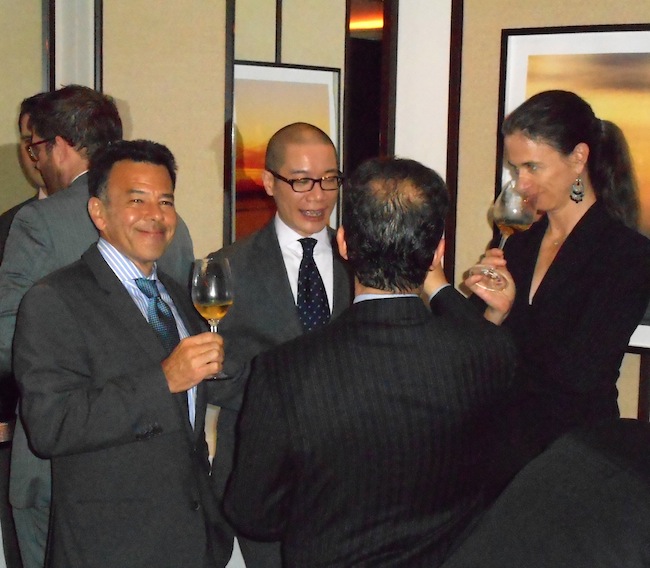 Perhaps the jewel in La Fête's crown this year was a special dinner held at New York's revered Daniel restaurant featuring the wines of Krug Champagne, a house whose wines are often equated to "haute couture" due to their unwavering attention to detail and commitment to excellence. Accompanying his wines was Olivier Krug, representing the 6th generation of the family who founded the legendary House in 1843. Also featured were Chef Arnaud Lallement, Chef and owner of both the 3 Michelin-starred restaurant, A. Lallement, and hotel, L'Assiette Champenoise in Reims and of course, our host for the evening, the esteemed Chef Daniel Boulud. Having had the pleasure of visiting Krug and staying at L'Assiette recently (for more on our visit, please click here), we didn't want to miss the opportunity to experience the duo stateside.
Perhaps the jewel in La Fête's crown this year was a special dinner held at New York's revered Daniel restaurant featuring the wines of Krug Champagne, a house whose wines are often equated to "haute couture" due to their unwavering attention to detail and commitment to excellence. Accompanying his wines was Olivier Krug, representing the 6th generation of the family who founded the legendary House in 1843. Also featured were Chef Arnaud Lallement, Chef and owner of both the 3 Michelin-starred restaurant, A. Lallement, and hotel, L'Assiette Champenoise in Reims and of course, our host for the evening, the esteemed Chef Daniel Boulud. Having had the pleasure of visiting Krug and staying at L'Assiette recently (for more on our visit, please click here), we didn't want to miss the opportunity to experience the duo stateside.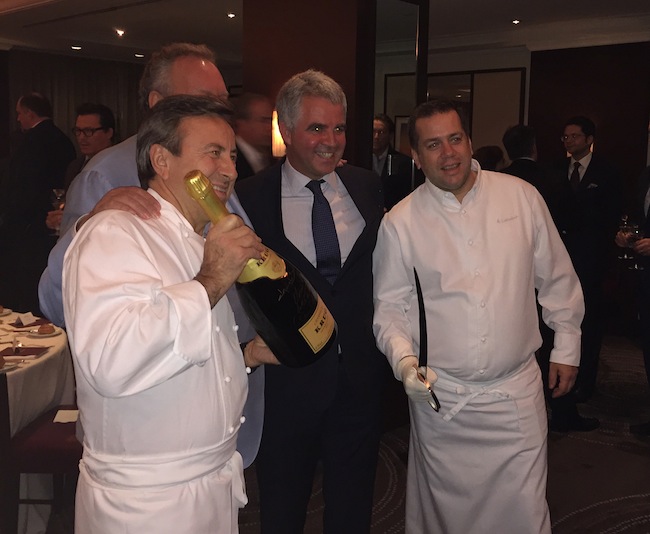 Upon arriving at Daniel on an unseasonably warm November evening, we were greeted with glasses of Krug Grande Cuvée poured en magnum - not a bad way to start any evening! Johnnes and Liem's event had warranted the attendance of many of the industry's best somms, including Boulud's own Raj Vaidya, Michael Madrigale, Edouard Bourgeois and Ian Hood as well as other notable names in the world of wine Master Sommelier Larry Stone, Eric Railsback and Patrick Cappiello among others. Passed hors d'oeuvres paired brilliantly with the Grande Cuvée and primed our palates for the deliciousness to come. As guests mixed and mingled, Chef Boulud playfully cradled a signed jeroboam of Krug Grande Cuvée while Lallement deftly handled a Champagne saber. Both were to be auctioned off later in the weekend to benefit ment'or, a nonprofit organization founded by Chefs Daniel Boulud, Thomas Keller and Jérôme Bocuse at the urging of legendary French Chef Paul Bocuse. The organization is devoted to inspiring culinary excellence and preserving the traditions and quality of American cuisine.
Upon arriving at Daniel on an unseasonably warm November evening, we were greeted with glasses of Krug Grande Cuvée poured en magnum - not a bad way to start any evening! Johnnes and Liem's event had warranted the attendance of many of the industry's best somms, including Boulud's own Raj Vaidya, Michael Madrigale, Edouard Bourgeois and Ian Hood as well as other notable names in the world of wine Master Sommelier Larry Stone, Eric Railsback and Patrick Cappiello among others. Passed hors d'oeuvres paired brilliantly with the Grande Cuvée and primed our palates for the deliciousness to come. As guests mixed and mingled, Chef Boulud playfully cradled a signed jeroboam of Krug Grande Cuvée while Lallement deftly handled a Champagne saber. Both were to be auctioned off later in the weekend to benefit ment'or, a nonprofit organization founded by Chefs Daniel Boulud, Thomas Keller and Jérôme Bocuse at the urging of legendary French Chef Paul Bocuse. The organization is devoted to inspiring culinary excellence and preserving the traditions and quality of American cuisine.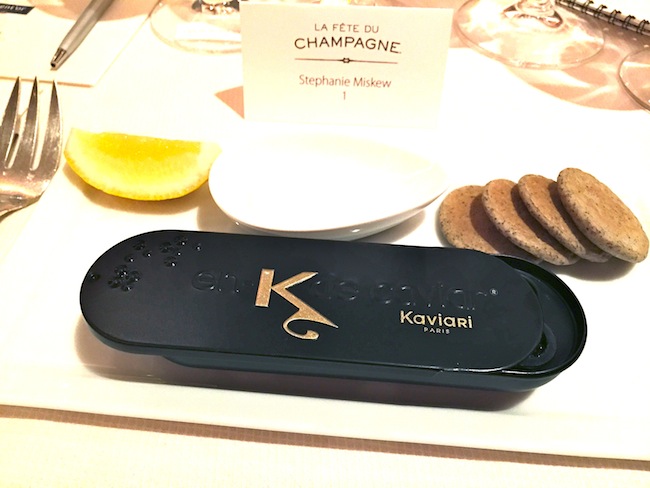
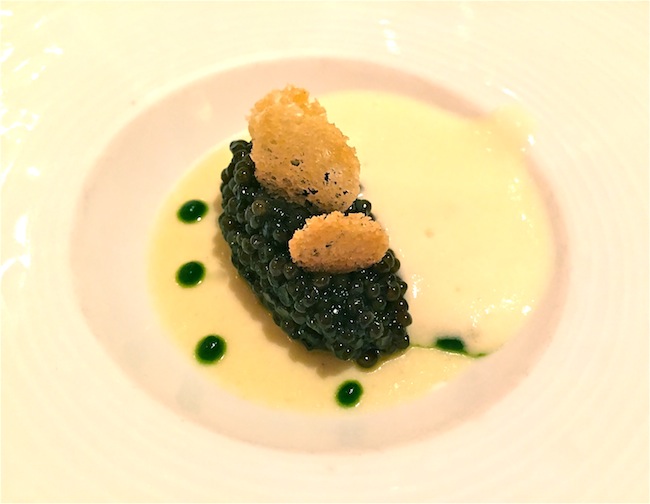
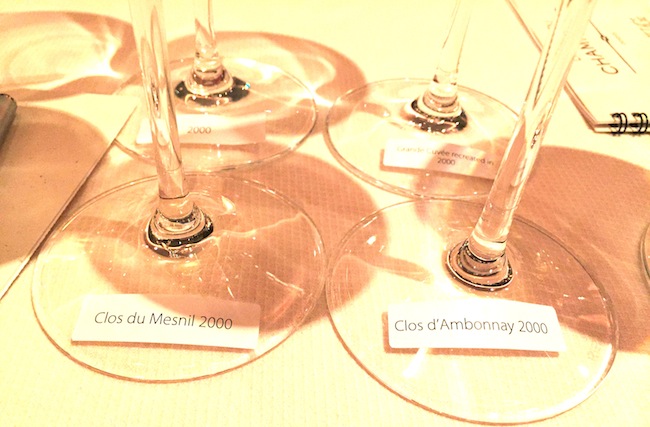 The evening's 5-course menu began decadently (was there any other way?) with a duo of caviar from Chef Lallement. First, a delightful black tin of caviar was accompanied by the classic accoutrements of blinis, crème fraîche and a wedge of lemon. Paired with the course were two Krug Champagnes, the 2000 Clos du Mesnil Blanc de Blancs and 2000 Clos d'Ambonnay Blanc de Noirs. While from the same vintage, the two wines represent a yin and yang of sorts. The Clos du Mesnil is made exclusively from Chardonnay harvested from the eponymous, 1.84 hectare, walled vineyard located in the heart of Mesnil-sur-Oger, one of the most iconic villages for Chardonnay in the Champagne region. The Clos d'Ambonnay, on the other hand, is made entirely from Pinot Noir from the Grand Cru village of Ambonnay. This similarly tiny, walled vineyard plot dates back to 1766 and is located on the southeastern slope of the Montagne de Reims. The two fifteen year old Champagnes showed beautifully and while clearly aging with grace, both are still incredibly fresh and youthful. The Clos d'Ambonnay slightly edged out the Clos du Mesnil in pairing with the first caviar, perhaps due to the wine's richer body and texture which synergized with the luxurious mouthfeel of the sturgeon roe. The second incarnation of caviar featured a decadent quenelle of roe atop creamy potato puree with haddock foam (shown above) which favored the acidity of the Clos du Mesnil Blanc de Blancs.
The evening's 5-course menu began decadently (was there any other way?) with a duo of caviar from Chef Lallement. First, a delightful black tin of caviar was accompanied by the classic accoutrements of blinis, crème fraîche and a wedge of lemon. Paired with the course were two Krug Champagnes, the 2000 Clos du Mesnil Blanc de Blancs and 2000 Clos d'Ambonnay Blanc de Noirs. While from the same vintage, the two wines represent a yin and yang of sorts. The Clos du Mesnil is made exclusively from Chardonnay harvested from the eponymous, 1.84 hectare, walled vineyard located in the heart of Mesnil-sur-Oger, one of the most iconic villages for Chardonnay in the Champagne region. The Clos d'Ambonnay, on the other hand, is made entirely from Pinot Noir from the Grand Cru village of Ambonnay. This similarly tiny, walled vineyard plot dates back to 1766 and is located on the southeastern slope of the Montagne de Reims. The two fifteen year old Champagnes showed beautifully and while clearly aging with grace, both are still incredibly fresh and youthful. The Clos d'Ambonnay slightly edged out the Clos du Mesnil in pairing with the first caviar, perhaps due to the wine's richer body and texture which synergized with the luxurious mouthfeel of the sturgeon roe. The second incarnation of caviar featured a decadent quenelle of roe atop creamy potato puree with haddock foam (shown above) which favored the acidity of the Clos du Mesnil Blanc de Blancs.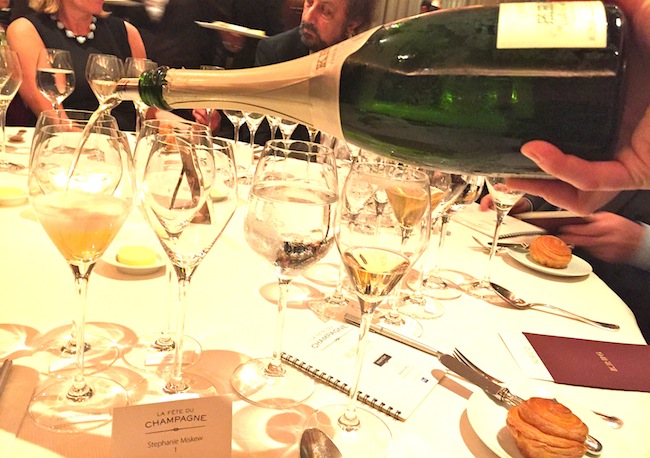
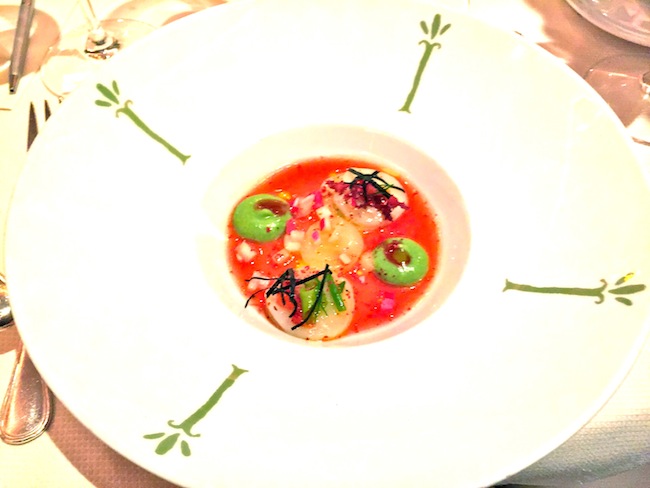 While the first two Champagnes were crafted from one grape and one vineyard from one year, the next duo were quite different. The Krug 2000 is a blend of the three classic Champagne grapes (43% Chardonnay, 42% Pinot Noir and 15% Pinot Meunier) from a variety of carefully selected plots from only one year. It represents a pure expression of the 2000 vintage, an exciting, chaotic year dubbed gourmandise orageuse or "stormy indulgence" by the house. The Krug Grande Cuvée (recreated in 2000) on the other hand was a blend of 118 base wines from 10 different years; the oldest vintage was from 1990, the youngest, 2000. Every bottle of Krug Champagne now features an iD code on the back which, when entered into the Krug website, provides a wealth of information on the wine including tasting notes from Chef de Caves, Eric Lebel, grape varieties used, disgorgement date as well as serving temperature and food pairing recommendations. Some wines even include a musical pairing which for the Krug 2000 is Keziah Jones's song "Lunar" - how's that for attention to detail? The two wines paired deliciously with Chef Boulud's Scallop Saint Jacques with fennel, espelette pepper and orange sanguine.
While the first two Champagnes were crafted from one grape and one vineyard from one year, the next duo were quite different. The Krug 2000 is a blend of the three classic Champagne grapes (43% Chardonnay, 42% Pinot Noir and 15% Pinot Meunier) from a variety of carefully selected plots from only one year. It represents a pure expression of the 2000 vintage, an exciting, chaotic year dubbed gourmandise orageuse or "stormy indulgence" by the house. The Krug Grande Cuvée (recreated in 2000) on the other hand was a blend of 118 base wines from 10 different years; the oldest vintage was from 1990, the youngest, 2000. Every bottle of Krug Champagne now features an iD code on the back which, when entered into the Krug website, provides a wealth of information on the wine including tasting notes from Chef de Caves, Eric Lebel, grape varieties used, disgorgement date as well as serving temperature and food pairing recommendations. Some wines even include a musical pairing which for the Krug 2000 is Keziah Jones's song "Lunar" - how's that for attention to detail? The two wines paired deliciously with Chef Boulud's Scallop Saint Jacques with fennel, espelette pepper and orange sanguine.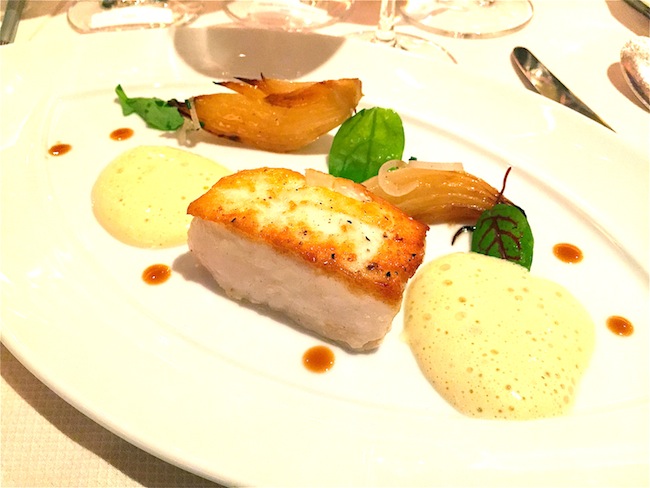 Chef Lallement's next offering was a succulent, perfectly cooked Halibut with Oignon Paille Vin Jaune which was paired with only one wine, the 1988 Krug Champagne. In contrast to the 2000, the '88 is predominantly Pinot Noir (50%), followed by Chardonnay (32%) and Pinot Meunier (18%) and the bottle served at the dinner was one of only 200 bottles kept at the House until 2015, well after the vintage was released, to gain "additional refinement and complexity." The wine's rich body and opulent, yet elegant flavors of apple galette, hazelnut, mandarin orange and spice made a delightful accompaniment for the delectable halibut. Krug's passion for his family's wines was evident throughout the dinner as he commented on each course, sharing details about Krug history and founder Joseph Krug's unwavering dedication to excellence. "The good house should offer two Champagnes of same quality with the same level of production...there is no hierarchy." He also shared, "There are times you might be tempted to keep elements of mediocre quality and it might work when you blend, it might work out but you should never rely on this option! Otherwise you might...lose your reputation. At Krug, there is no compromise on quality!"
Chef Lallement's next offering was a succulent, perfectly cooked Halibut with Oignon Paille Vin Jaune which was paired with only one wine, the 1988 Krug Champagne. In contrast to the 2000, the '88 is predominantly Pinot Noir (50%), followed by Chardonnay (32%) and Pinot Meunier (18%) and the bottle served at the dinner was one of only 200 bottles kept at the House until 2015, well after the vintage was released, to gain "additional refinement and complexity." The wine's rich body and opulent, yet elegant flavors of apple galette, hazelnut, mandarin orange and spice made a delightful accompaniment for the delectable halibut. Krug's passion for his family's wines was evident throughout the dinner as he commented on each course, sharing details about Krug history and founder Joseph Krug's unwavering dedication to excellence. "The good house should offer two Champagnes of same quality with the same level of production...there is no hierarchy." He also shared, "There are times you might be tempted to keep elements of mediocre quality and it might work when you blend, it might work out but you should never rely on this option! Otherwise you might...lose your reputation. At Krug, there is no compromise on quality!"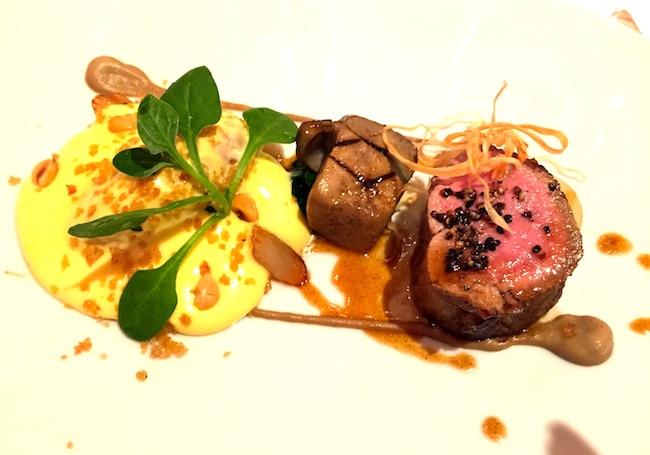 Our final savory course of the evening was Chef Boulud's Veaux de Lait with Quenelle aux Ceps and Sabayon au Champagne paired with the Krug Rosé en jeroboam. This particular bottle was a blend of 56% Pinot Noir, 30% Chardonnay and 14% Pinot Meunier, bottled in the Spring of 2014, after resting quietly in the Krug cellars for eight years. The heady aromatics of this Champagne never cease to release a surge of endorphins into my bloodstream, with fragrant notes of wild strawberry, freshly baked brioche and spice! Skin-fermented Pinot Noir imparts the wine's seductive pink color which, together with its fine, lively bead of bubbles, is the vinous equivalent of a strip tease. On the palate, this wine delivered everything it promised and the pairing was exquisite. When commenting on this particular cuvée, Krug expounded on a comment made by a certain celebrity who has been very forthcoming about her infatuation with Krug Rosé Champagne. Of course I'm talking about my own personal idol, Madonna, who has confessed her guilty pleasure is enjoying Krug Rosé and french fries. To hear Krug's comment on this, please watch the video below - I agree with his perspective 100%!To cap off the evening, we enjoyed the Krug Collection 1985 en magnum paired with a generous wedge of Vivace, a small production, mixed-milk cheese from fromage goddess Soyoung Scanlan's artisanal Andante Dairy in California. The delightful cheese had a thin, bloomy rind encasing a dense, rich paste which echoed the luxurious, nuanced texture of the Champagne. This offering displayed the beautiful patina of age with notes of toffee, honey, gingerbread and spice with a hint of white truffle and hazelnut on the lengthy finish. Aged Champagne is always a special thing but aged Krug is something else entirely - it is surely what is served as you are ushered into the pearly gates!As far as wine events go, La Fête du Champagne's decadent Krug dinner was truly a food and Champagne lover's mic drop moment. After kicking off the weekend with this heavenly dinner I couldn't help but wonder how the other events would compare. Thankfully, this wonderful dinner, while the highlight, set a standard of excellence which was sustained throughout the weekend by a variety of well-curated events and seminars, but more on that later this week.Cheers,
Our final savory course of the evening was Chef Boulud's Veaux de Lait with Quenelle aux Ceps and Sabayon au Champagne paired with the Krug Rosé en jeroboam. This particular bottle was a blend of 56% Pinot Noir, 30% Chardonnay and 14% Pinot Meunier, bottled in the Spring of 2014, after resting quietly in the Krug cellars for eight years. The heady aromatics of this Champagne never cease to release a surge of endorphins into my bloodstream, with fragrant notes of wild strawberry, freshly baked brioche and spice! Skin-fermented Pinot Noir imparts the wine's seductive pink color which, together with its fine, lively bead of bubbles, is the vinous equivalent of a strip tease. On the palate, this wine delivered everything it promised and the pairing was exquisite. When commenting on this particular cuvée, Krug expounded on a comment made by a certain celebrity who has been very forthcoming about her infatuation with Krug Rosé Champagne. Of course I'm talking about my own personal idol, Madonna, who has confessed her guilty pleasure is enjoying Krug Rosé and french fries. To hear Krug's comment on this, please watch the video below - I agree with his perspective 100%!To cap off the evening, we enjoyed the Krug Collection 1985 en magnum paired with a generous wedge of Vivace, a small production, mixed-milk cheese from fromage goddess Soyoung Scanlan's artisanal Andante Dairy in California. The delightful cheese had a thin, bloomy rind encasing a dense, rich paste which echoed the luxurious, nuanced texture of the Champagne. This offering displayed the beautiful patina of age with notes of toffee, honey, gingerbread and spice with a hint of white truffle and hazelnut on the lengthy finish. Aged Champagne is always a special thing but aged Krug is something else entirely - it is surely what is served as you are ushered into the pearly gates!As far as wine events go, La Fête du Champagne's decadent Krug dinner was truly a food and Champagne lover's mic drop moment. After kicking off the weekend with this heavenly dinner I couldn't help but wonder how the other events would compare. Thankfully, this wonderful dinner, while the highlight, set a standard of excellence which was sustained throughout the weekend by a variety of well-curated events and seminars, but more on that later this week.Cheers,
Coco Chanel, Bette Davis, Oscar Wilde, Madame de Pompadour, Marlene Dietrich, Winston Churchill. A list of famous Champagne fans reads like a line out of Madonna’s song “Vogue,” and last month marked the 2nd Annual La Fête du Champagne, a celebration of the iconic French wine region whose name is synonymous with glamour. Held in New York City, the event is the brainchild of Daniel... Read More
The post La Fête du Champagne: Krug Dinner at Daniel feat. Special Guests Olivier Krug & Chef Arnaud Lallement appeared first on The Glamorous Gourmet.
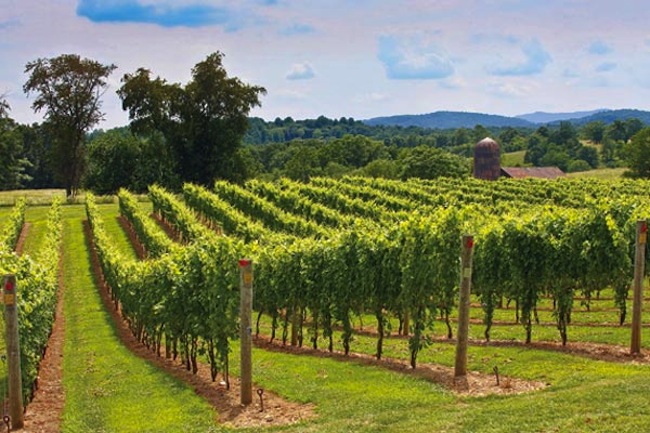
virginia-wine-country-vineyard
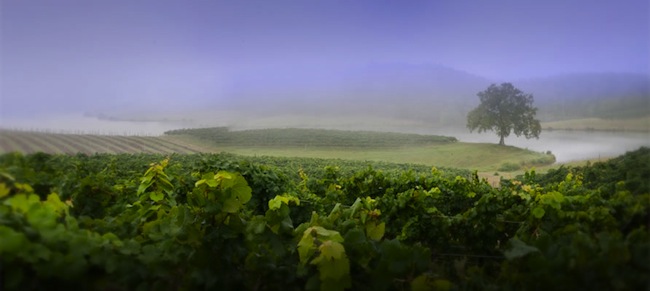
north-carolina-biltmore-estate
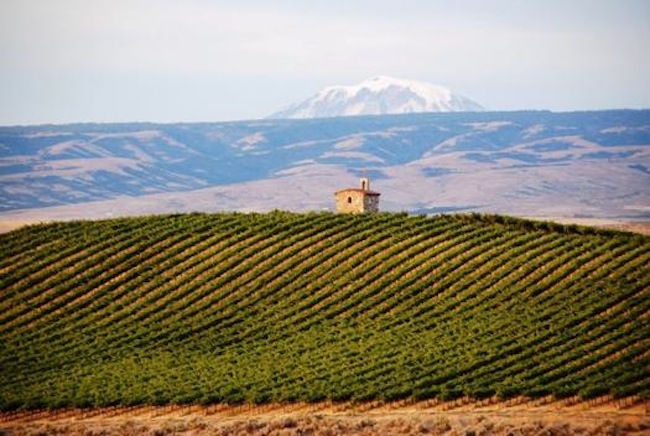
washington-chapel-block-vineyard
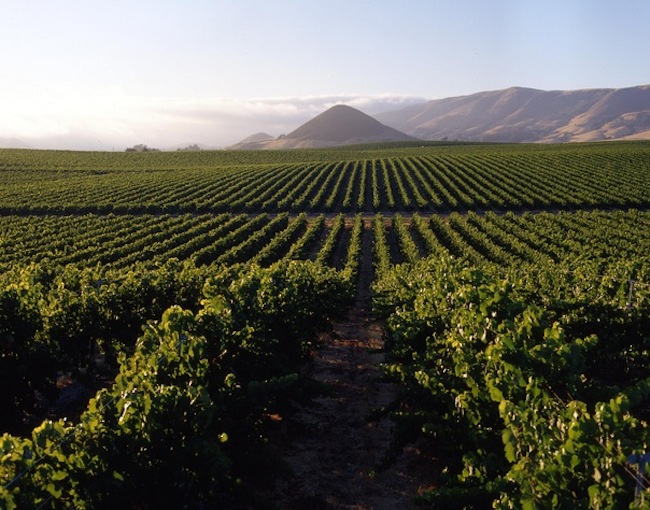
new-mexico-vineyard
Wine is produced in all 50 states so why do we automatically think of California when we hear the term "wine country"? Saturday, November 7th marks the 3rd Annual Wine Tourism Day and in honor of this vinous holiday, I'm happy to share 4 US wine regions you need to add to your travel itinerary:1.) Virginia: Wine production began here in 1607, when government regulations stipulated each male settler in Jamestown must plant and tend at least 10 grapevines to produce wine which was sent back to Mother England. In 1807, Thomas Jefferson began cultivating European grapes at his Monticello Estate and has since been dubbed "The Father of the American Wine Industry" even though he didn't have much success actually making wine. While Virginia's wine industry began primarily with indigenous American grape varieties, mostly vitis vinifera vines (European vines such as Chardonnay, Cabernet Franc, Cabernet Sauvignon) are grown today with a smaller percentage of French hybrids and American varieties. Virginia currently ranks 5th in the US in overall number of wineries and its the country's 5th largest grape producer. Grapes which perform well in the state's warm climate include Viognier, Chardonnay, Cabernet Franc, Merlot and Vidal Blanc. For more information on Virginia Wine Country please click here and be sure to put the following wineries on your list: Barboursville Vineyards, Horton Vineyards, Trump Winery (formerly Kluge Estate), RdV Vineyards, and Linden Vineyards.2.) North Carolina: Wine has been produced here since the early days of European colonization in the 17th century and like most budding wine regions in the United States, it was originally based on indigenous American vines and was ultimately decimated by Prohibition in the 1920's. North Carolina's wine industry has slowly recovered over the years and today, most wine produced is made from vitis vinifera vines although French hybrids and vitis labrusca varieties are also common. North Carolina is home to over 100 wineries, which has quadrupled since 2001 and ranks 10th in both grape and wine production in the US. The state's wine industry continues to expand, and today is one of the US’s 5 most visited state destinations for wine and culinary tourism. For more information on North Carolina Wine Country please click here and be sure to add these wineries to your list: Biltmore Estate, Raffaldini Vineyards, Jones von DrehleandWestbend Vineyards & Brewery.3.) Washington: As the second leading producer of wine in the United States you'd think Washington would attract as many visitors as California but that's not the case...yet! The first grape vines were planted here in 1825 by fur traders and German and Italian immigrants in the Walla Walla region. The state was also decimated by Prohibition in the 1920's, and Washington's wine industry floundered until the 1950’s when vitis viniferagrapes were introduced and in depth study was conducted of soil, climate and grape vine viability. In the 1950's and 60's, the precursors of the state's biggest wineries Chateau Ste Michelle and Columbia Winery were founded and over the ensuing years Washington' ability to cater to a variety of grapes became evident. In 1984, the Columbia Valley AVA (American Viticultural Area) was established which today, contains 99% of wine grapes grown in the state. Grape varieties which have adapted particularly well to Washington's wine country are Chardonnay, Riesling, Merlot, Viognier, Cabernet Sauvignon and Syrah. For more information on Washington Wine Country, please click here and be sure to add the following wineries to your list: Chateau Ste. Michelle, Seven Hills Winery, Charles Smith Wines, Cayuse Vineyards, Northstar Wineryand Canoe Ridge Vineyards.4.) New Mexico: Wine has been produced in here since 1629, when a Franciscan friar and Capuchín monk planted the first wine grapes in the Río Grande valley. The cuttings brought by the missionaries were a variety of vitis vinifera, commonly called the "mission grape" which is still grown in New Mexico today. By 1880, viticulture had really taken hold, but declined in the latter 19th century due, in part, to flooding of the Río Grande and Prohibition which forced many wineries in the United States to close. The modern New Mexico wine industry received a significant shot in the arm in 1978 when a government-sponsored study encouraged winegrowers to plant French hybrid grape varieties. New Mexico now has more than 60 wineries producing 900,000 US gallons of wine annually. The state's sun-soaked soil and cool high-desert nights frame the return of modern wine making producing Cabernet Sauvignon, Chardonnay, Johannisburg Riesling, Merlot, Pinot Noir, Sauvignon Blanc & Zinfandel. Wineries currently span the breadth of the state For more information on New Mexico wine country, please click here and be sure to add the following wineries to your itinerary: Gruet Winery, Caduceus Cellars, Casa Rondeña, Luna Rossa Winery, Tularosa Vineyards.Cheers,
Wine is produced in all 50 states so why do we automatically think of California when we hear the term “wine country”? Saturday, November 7th marks the 3rd Annual Wine Tourism Day and in honor of this vinous holiday, I’m happy to share 4 US wine regions you need to add to your travel itinerary: 1.) Virginia: Wine production began here in 1607, when government... Read More
The post Wine Tourism Day: 4 US Wine Regions You Need to Visit appeared first on The Glamorous Gourmet.
"My mistress' eyes are nothing like the sun; my hunger for her explains everything I've done. To howl at the moon the whole night through; and they really don't care if I do. I'd go out of my mind, but for you." - Sting, Sister Moon
Oenology. Philanthropy. History. Music. These elements harmoniously converge at Il Palagio, the idyllic Tuscan estate of husband and wife team and power couple, Sting and Trudie Styler. In 1990 Trudie embarked on an odyssey to find an Italian retreat for her family that would exist for more than just their own personal pleasure. A dedicated supporter of humanitarian efforts, Trudie wanted a property that would also benefit the community and in 1997, seven years after beginning her quest, she finally found it.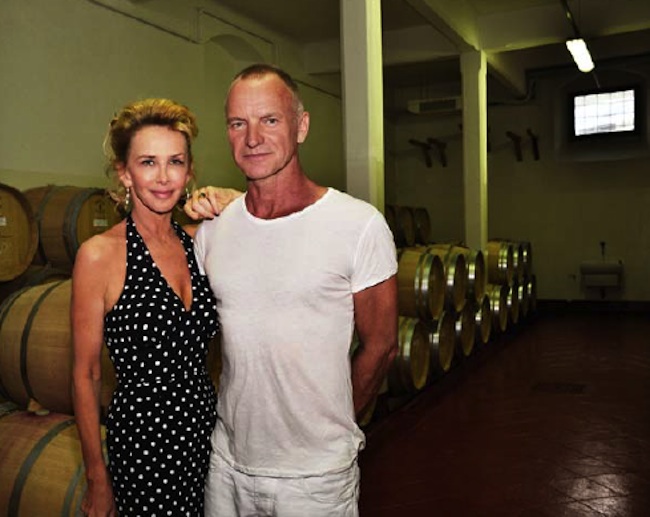 Il Palagio dates back to the mid-1500's and since then has changed hands among a variety of noble, Tuscan families. In 1819, however, it was sold to the Countess Carlotta Barbolani of Montauto and the property remained in her family for almost two hundred years. During this time the estate revolved around agriculture, producing wine, olive oil, wheat, corn, sugar beets, peaches, apricots and cherries. At the time of Trudie's discovery, its current owner, Duke Simone Velluti Zati di San Clemente, a descendant of Countess Carlotta, had found it exceedingly difficult to financially maintain the large villa and sprawling property and was happy to accept Trudie and Sting’s “interesting offer.”Over the following decade, Sting and Trudie lovingly restored the estate and doubled its size by reacquiring land sold off during the family's times of financial difficulty. Today, the estate consists of a sprawling 865 acres, 65 of which are planted to grapevines. Under the direction of the late, famed viticulturist Alan York, known for his organic and biodynamic approach to agriculture, 27 acres of ailing vines were replaced and the estate was converted to biodynamic farming.
Il Palagio dates back to the mid-1500's and since then has changed hands among a variety of noble, Tuscan families. In 1819, however, it was sold to the Countess Carlotta Barbolani of Montauto and the property remained in her family for almost two hundred years. During this time the estate revolved around agriculture, producing wine, olive oil, wheat, corn, sugar beets, peaches, apricots and cherries. At the time of Trudie's discovery, its current owner, Duke Simone Velluti Zati di San Clemente, a descendant of Countess Carlotta, had found it exceedingly difficult to financially maintain the large villa and sprawling property and was happy to accept Trudie and Sting’s “interesting offer.”Over the following decade, Sting and Trudie lovingly restored the estate and doubled its size by reacquiring land sold off during the family's times of financial difficulty. Today, the estate consists of a sprawling 865 acres, 65 of which are planted to grapevines. Under the direction of the late, famed viticulturist Alan York, known for his organic and biodynamic approach to agriculture, 27 acres of ailing vines were replaced and the estate was converted to biodynamic farming.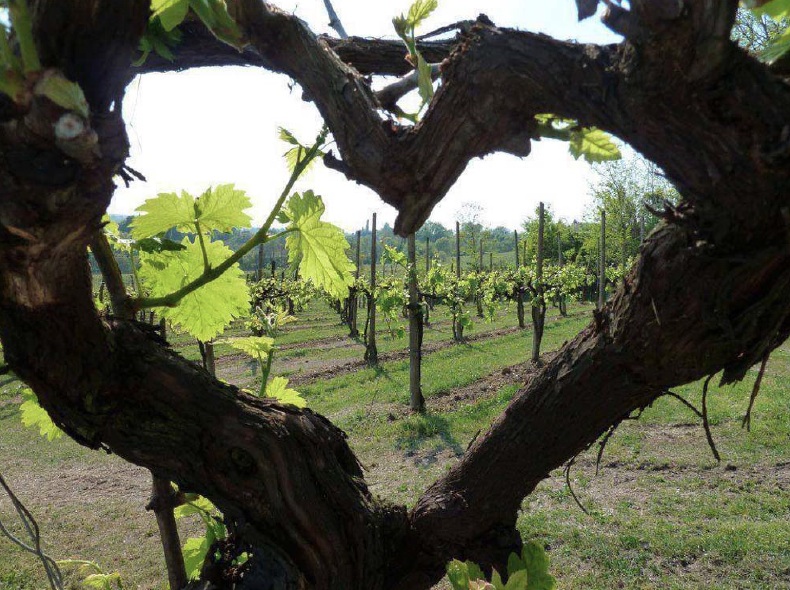 Grapes aren't the only thing currently grown at Il Palagio. The estate's olive groves consist of 8,000, centuries-old trees and happen to be Sting's favorite spot on the property. They were returned to full production under the watchful eye of estate manager, Paolo Rossi, who was born on the estate and has remained there his entire life. Trudie's passion project is the establishment of bee colonies and she and Paolo have built happy homes for over 80 of them. “I have a huge belief in the importance of bees, not just for their honey which is a healing and delicious food, but the necessity of bee colonies that are vital to the health of the planet,” she shares. Sting and Trudie are currently in the process of importing their organic olive oil and honey to the United States and, in keeping with their philanthropic nature, a portion of the proceeds from the sale of these products will benefit charities near and dear to their hearts.
Grapes aren't the only thing currently grown at Il Palagio. The estate's olive groves consist of 8,000, centuries-old trees and happen to be Sting's favorite spot on the property. They were returned to full production under the watchful eye of estate manager, Paolo Rossi, who was born on the estate and has remained there his entire life. Trudie's passion project is the establishment of bee colonies and she and Paolo have built happy homes for over 80 of them. “I have a huge belief in the importance of bees, not just for their honey which is a healing and delicious food, but the necessity of bee colonies that are vital to the health of the planet,” she shares. Sting and Trudie are currently in the process of importing their organic olive oil and honey to the United States and, in keeping with their philanthropic nature, a portion of the proceeds from the sale of these products will benefit charities near and dear to their hearts.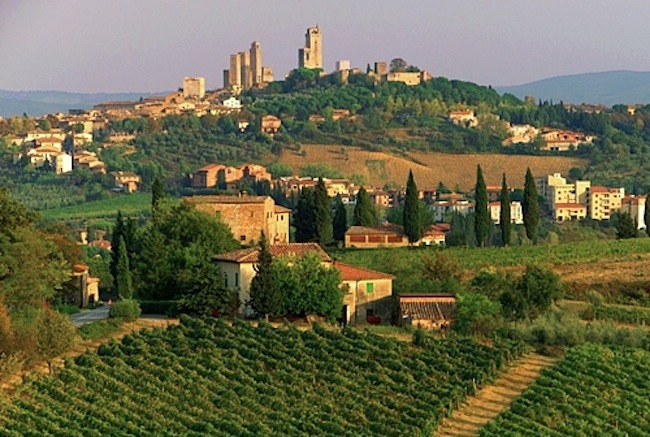 When it comes to wine, the Il Palagio vines are currently in the capable hands of Winemaker, Paolo Caciorgna, and Vineyard Manager and Winemaker, Daniel O'Donnell, who took over for an ailing Alan York in 2013. The Sienese Caciorgna was born into a winemaking family and, after formally studying wine, enjoyed appointments in both California and France before becoming a consultant in 1997. International winemaker and consultant O'Donnell has experience making wine in such diverse regions as Chile, Argentina, Turkey, France, Italy, Uruguay and California. O'Donnell is known for producing wines "of place" and is currently implementing improvements in the Il Palagio vineyards which include rehabilitating older vines and adjusting yields.
When it comes to wine, the Il Palagio vines are currently in the capable hands of Winemaker, Paolo Caciorgna, and Vineyard Manager and Winemaker, Daniel O'Donnell, who took over for an ailing Alan York in 2013. The Sienese Caciorgna was born into a winemaking family and, after formally studying wine, enjoyed appointments in both California and France before becoming a consultant in 1997. International winemaker and consultant O'Donnell has experience making wine in such diverse regions as Chile, Argentina, Turkey, France, Italy, Uruguay and California. O'Donnell is known for producing wines "of place" and is currently implementing improvements in the Il Palagio vineyards which include rehabilitating older vines and adjusting yields.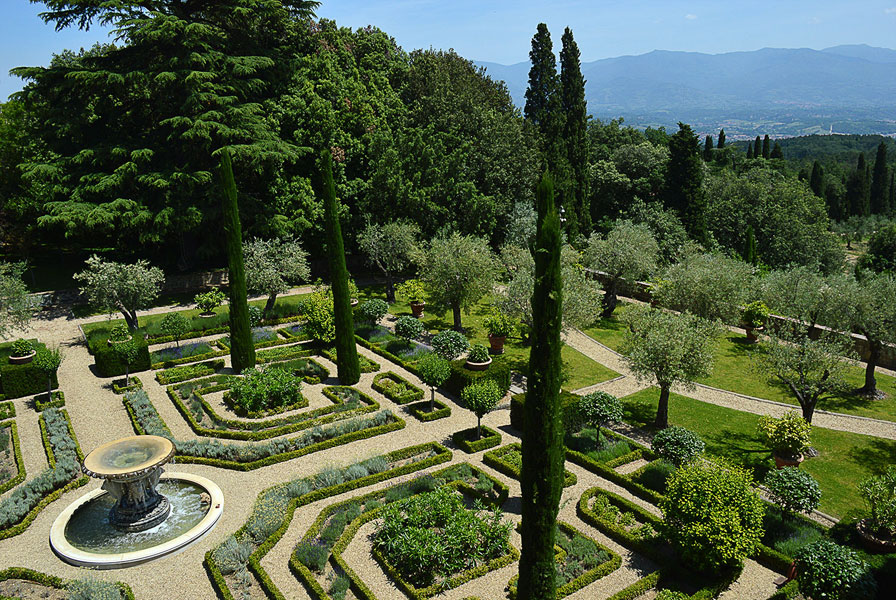 I recently had the pleasure of sampling the Il Palagio wines which include four offerings, all predicated on Tuscany's signature red grape, Sangiovese. The wines first entice with their labels featuring eye-catching artwork ranging from whimsical, figural poses to lovely, handwritten script in muted tones of grey, red, and black. Unlike many celebrity wines on the market today, however, the Il Palagio wines do not need to rely on their aesthetically pleasing labels! The care and time Sting and Trudie have devoted to their beloved estate definitely shines through in their delightful line of wines which each represent a unique expression of the Sangiovese grape.
I recently had the pleasure of sampling the Il Palagio wines which include four offerings, all predicated on Tuscany's signature red grape, Sangiovese. The wines first entice with their labels featuring eye-catching artwork ranging from whimsical, figural poses to lovely, handwritten script in muted tones of grey, red, and black. Unlike many celebrity wines on the market today, however, the Il Palagio wines do not need to rely on their aesthetically pleasing labels! The care and time Sting and Trudie have devoted to their beloved estate definitely shines through in their delightful line of wines which each represent a unique expression of the Sangiovese grape.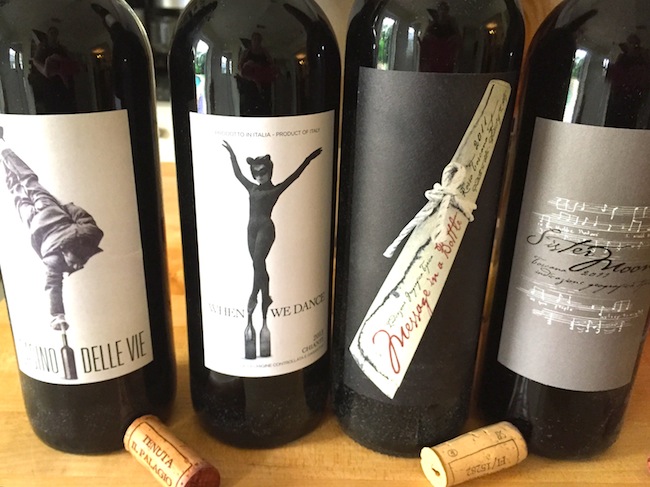 Also, in keeping with the Italian ethos that wine is meant to be enjoyed with food, I whipped up the classic Tuscan dish, Bistecca alla Fiorentina, to pair with the Il Palagio wines. While it is traditionally made from Tuscan Chianina beef, I made do with a gorgeous Choice Hereford Porterhouse steak from Fresh Market which was incredibly flavorful and delicious. The recipe also couldn't be easier since the steak is seasoned only with olive oil, salt and pepper to allow the natural flavor of the meat to shine through. It made a perfect accompaniment for the wines and the recipe and my tasting notes are below:1.) 2011 Il Palagio Sister Moon IGT, Toscana, Italy ($56): Named for Sting's eponymous song, Sister Moon is the flagship wine of the Il Palagio estate. This 2011 Super Tuscan is a blend of 45% Sangiovese, 45% Merlot and 10% Cabernet Sauvignon aged for 15-18 month in oak barriques and an additional six months in bottle. The wine is a lovely garnet/purple color with aromas of blackberry, violet and spice. On the palate, this elegant, well-balanced wine displays a beautiful integration of black and red fruit, supple tannins and food friendly acidity. While drinking beautifully now, this wine could also evolve in the cellar nicely for 5-10 years.2.) 2011 Il Palagio Casino delle Vie IGT, Toscana, Italy ($30): The second Super Tuscan of the portfolio is named for a property on the estate which, literally translated, means ‘little house by the roads.' This blend of 75% Sangiovese, 15% Cabernet Sauvignon, 10% Merlot and Cabernet Franc is aged for 12 months in used barriques and an additional six months in bottle. The result is a wine with a deep garnet/purple color and aromas of ripe dark fruit and spice. On the palate, mouth-filling, lush flavors of wild blackberry, black currant, leather and licorice accompany sweet tannins.3.) 2011 Il Palagio Message in a Bottle, Toscana, Italy ($20): Named for one of Sting's most popular songs, this wine is a blend of 70% Sangiovese, 15% Syrah and 15% Merlot fermented in stainless steel and aged in bottle for four months. This wine has a fresh, youthful purple/garnet color with fragrant aromas of plummy dark fruit, cassis and black pepper. On the palate, ripe black cherry, wild strawberry and spice are accompanied by supple tannins, a lively acidity and bitter almond-tinged finish.4.) 2013 Il Palagio When We Dance Chianti, Toscana, Italy ($19): Also named for one of Sting's songs this is a great "everyday" offering from the estate. The 2013 is a blend of 90% Sangiovese, 5% Canaiolo and 5% Colorino fermented entirely in stainless steel and aged in bottle three months prior to release. This wine has a classic translucent garnet color and aromas of red and black fruit and earth. On the palate, this easy drinking wine offers flavors of cherry, red berries, orange peel, baked earth and spice with mild tannins and a tart finish.
Also, in keeping with the Italian ethos that wine is meant to be enjoyed with food, I whipped up the classic Tuscan dish, Bistecca alla Fiorentina, to pair with the Il Palagio wines. While it is traditionally made from Tuscan Chianina beef, I made do with a gorgeous Choice Hereford Porterhouse steak from Fresh Market which was incredibly flavorful and delicious. The recipe also couldn't be easier since the steak is seasoned only with olive oil, salt and pepper to allow the natural flavor of the meat to shine through. It made a perfect accompaniment for the wines and the recipe and my tasting notes are below:1.) 2011 Il Palagio Sister Moon IGT, Toscana, Italy ($56): Named for Sting's eponymous song, Sister Moon is the flagship wine of the Il Palagio estate. This 2011 Super Tuscan is a blend of 45% Sangiovese, 45% Merlot and 10% Cabernet Sauvignon aged for 15-18 month in oak barriques and an additional six months in bottle. The wine is a lovely garnet/purple color with aromas of blackberry, violet and spice. On the palate, this elegant, well-balanced wine displays a beautiful integration of black and red fruit, supple tannins and food friendly acidity. While drinking beautifully now, this wine could also evolve in the cellar nicely for 5-10 years.2.) 2011 Il Palagio Casino delle Vie IGT, Toscana, Italy ($30): The second Super Tuscan of the portfolio is named for a property on the estate which, literally translated, means ‘little house by the roads.' This blend of 75% Sangiovese, 15% Cabernet Sauvignon, 10% Merlot and Cabernet Franc is aged for 12 months in used barriques and an additional six months in bottle. The result is a wine with a deep garnet/purple color and aromas of ripe dark fruit and spice. On the palate, mouth-filling, lush flavors of wild blackberry, black currant, leather and licorice accompany sweet tannins.3.) 2011 Il Palagio Message in a Bottle, Toscana, Italy ($20): Named for one of Sting's most popular songs, this wine is a blend of 70% Sangiovese, 15% Syrah and 15% Merlot fermented in stainless steel and aged in bottle for four months. This wine has a fresh, youthful purple/garnet color with fragrant aromas of plummy dark fruit, cassis and black pepper. On the palate, ripe black cherry, wild strawberry and spice are accompanied by supple tannins, a lively acidity and bitter almond-tinged finish.4.) 2013 Il Palagio When We Dance Chianti, Toscana, Italy ($19): Also named for one of Sting's songs this is a great "everyday" offering from the estate. The 2013 is a blend of 90% Sangiovese, 5% Canaiolo and 5% Colorino fermented entirely in stainless steel and aged in bottle three months prior to release. This wine has a classic translucent garnet color and aromas of red and black fruit and earth. On the palate, this easy drinking wine offers flavors of cherry, red berries, orange peel, baked earth and spice with mild tannins and a tart finish.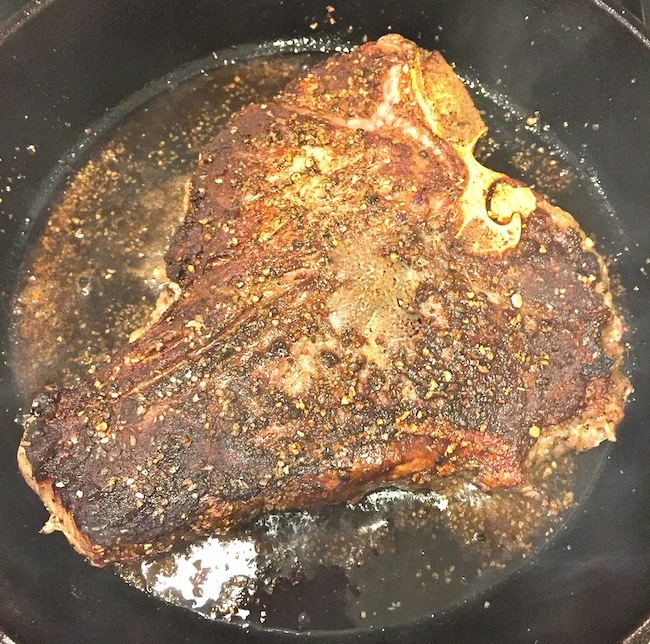 "Bistecca all Fiorentina"Serves 2-42lb. Porterhouse Steak, at least 1 1/2-2 inches thickGood Olive OilKosher or Sea SaltCoarse grind black pepper1.) Take the steak out of the refrigerator 30 minutes prior to cooking. The steak can either be prepared on a grill or pan-roasted in which case you'll need to preheat the oven to 450 degrees.2.) Coat the steak lightly in olive oil and then liberally season both sides with salt and pepper, pressing the seasoning into the meat. If grilling, grill the steaks for about 5-6 minutes on each side for medium rare. The fillet will cook a little faster than the strip so be sure to move the steak every 2 minutes or so for even cooking.3.) If pan roasting, heat your cast iron skillet until very hot. Place the seasoned steak in the center of the pan and cook until the first side is seared brown - approximately 4 minutes. Turn the steak and immediately place the pan in the pre-heated oven until done, about 4-5 minutes for medium rare. Remove the steak to a carving board and let rest for 5 minutes before carving.4.) Cut the steaks away from the bone and carve into 1/2-inch slices. Serve with extra salt and pepper and with a side dish of white beans and/or an arugula salad.Cheers,
"Bistecca all Fiorentina"Serves 2-42lb. Porterhouse Steak, at least 1 1/2-2 inches thickGood Olive OilKosher or Sea SaltCoarse grind black pepper1.) Take the steak out of the refrigerator 30 minutes prior to cooking. The steak can either be prepared on a grill or pan-roasted in which case you'll need to preheat the oven to 450 degrees.2.) Coat the steak lightly in olive oil and then liberally season both sides with salt and pepper, pressing the seasoning into the meat. If grilling, grill the steaks for about 5-6 minutes on each side for medium rare. The fillet will cook a little faster than the strip so be sure to move the steak every 2 minutes or so for even cooking.3.) If pan roasting, heat your cast iron skillet until very hot. Place the seasoned steak in the center of the pan and cook until the first side is seared brown - approximately 4 minutes. Turn the steak and immediately place the pan in the pre-heated oven until done, about 4-5 minutes for medium rare. Remove the steak to a carving board and let rest for 5 minutes before carving.4.) Cut the steaks away from the bone and carve into 1/2-inch slices. Serve with extra salt and pepper and with a side dish of white beans and/or an arugula salad.Cheers,